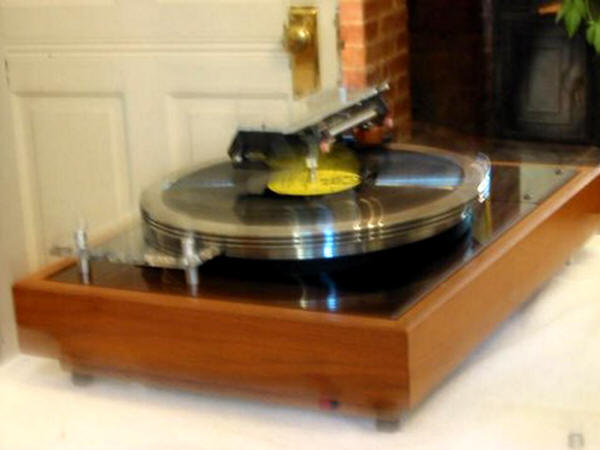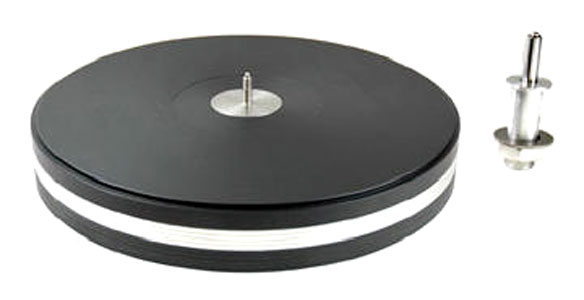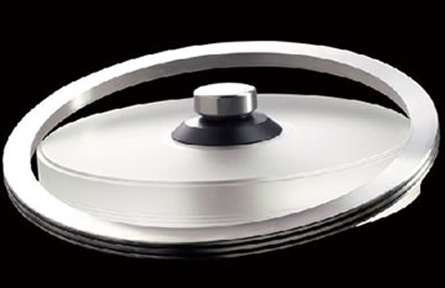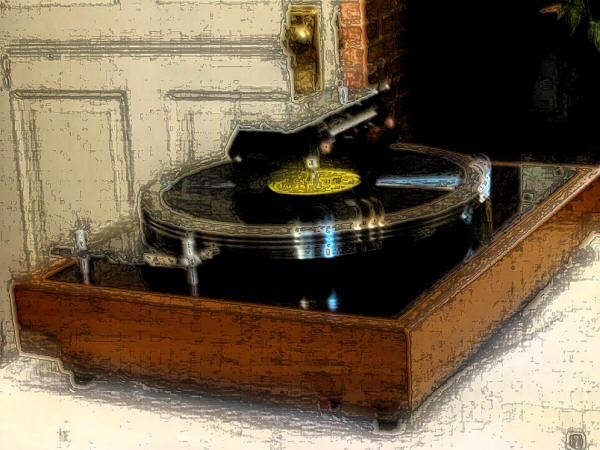You are reading the older HTML site
Positive Feedback ISSUE
january/february 2008
The V.P.I. HW-19 Parts Kit: or, The Only
Good Turntable is a Dead Turntable
by Max Dudious

[All photographs by Max "f/64 Group" Dudious unless otherwise noted; image processing by Robinson]

Bouncy Floors
Somewhat over twenty years ago I invested in a V.P.I. HW-19 turntable. It was the top of the VPI line then, and today it is considered a kind of "specialty niche item," being the only sprung suspension table in the line. Somewhere along the way someone decided that hard suspension tables were better sonic performers, and producing them became a standard operating procedure for turntable manufacturers. Well, that may be true for people who have poured concrete floors, as in some basement listening rooms, or who can bolt a shelf to an outside brick wall. I happen to live in a 124 year old, wooden, balloon-frame-construction house, similar to the typical 5-peak-roofed houses you see in San Francisco photos and paintings. My house has some nice things, like lath and plaster walls, high ceilings, oak floors, and an L-shaped listening space; and some not so nice things: drafts and (principally) bouncy floors. Trade-offs; always trade-offs. It is imperative that any turntable I would own be able to withstand people walking across the floor without jolting the tone-arm out of the groove. On that score, my HW-19 has served me well.
Tweaks: Iterations and Re-iterations
Five (?) years back, I decided to upgrade my table at the '03 NY Home Entertainment Show after a conversation with Harry Weisfeld, the HW designer of my HW-19 turntable. Harry had been doing a lot of tweaking of that table, now known as the HW-19 IV, mostly involving substituting black Plexiglass™ for the tone-arm plinth and the turntable plinth that were originally made of Medium Density Fiberboard. This was not merely a cosmetic concern (as is the plexi-dust-guard over the belt pulley), though it was better looking, but a sonic concern as well. Black Plexiglass™ is noticeably quieter when compared to the medium density fiberboard (MDF) he used in previous models. When I plunked a standard pencil, eraser for the business end, onto the MDF plinths while playing a record, there was a good deal of noise transmitted and fed back to the cartridge. Each thump was moderately loud. When I did the same onto the Plexiglass™ plinths the noise was still audible, but much reduced and with quicker decay. The result was an overall greater precision of the sound: greater retrieval of micro-sonic details, sharpening of transients' leading edges, etc.
When I asked Harry about that, he replied, slyly, that black plexi "didn't vibrate much," converting kinetic energy (such as a pencil plunk) into heat. Nice thing to know. Of course, it didn't hurt things any to have the Plexi-plinth stuck to the steel plates beneath it with silicone glue. The MDF-plinth used the same adhesive, so that was a wash. This coincided with the whole industry's (even speaker manufacturers) rushing to embrace black-plexi parts in strategic places. Clear-plexi has a somewhat different sonic profile. In the end, I found a mixture of black and clear gave a very flat frequency response to my turntable/tonearm, damping out resonances and airborne vibrations. By the way, Harry wasn't the first guy to say, "The Only Good Turntable is a Dead Turntable." That might have been Mitch Cotter, but it might as well have been Harry; he's been operating under that imperative for two or three decades.
Harry also encouraged me to swap my lathe-turned, slightly warped, aluminum turntable platter for a 10 lb. translucent white plexi-platter, with the inverted bearing up in "umbrella" configuration, as used in the Scout turntable. I could hear the quieting the acrylic brought to the table, but I wasn't able to hear any differences between the platter with (and without) my concave Osaka mat. I decided on the Scout plexi-platter with the Osaka mat, which was pretty inert, to take advantage of the slight concavity it had. This helped correct for the centrifugal force acting on the cartridge in my Souther Tri-Quartz linear-tracking tone arm. The results: zero tracking error from outer edge to the label, less "smearing," hence better resolution, and much improved quietness.
Clearaudio Harness
About that time, I managed to get a super lightweight wiring harness from Clearaudio that eliminated two solder joints per individual wire (with four color-coded sheaths that fit over my cartridge's pins, and two RCA female, metallurgically correct and Teflon insulated, chassis-mount jacks). Clearaudio had become the fabricator and distributor of the Souther arm, and their own (heavier, clear-plexi reinforced) variation on it. My vinyl sound improved about another notch in performance: cleaner interconnects yielded less annoying sibilance, or "shushing." It's funny how you don't notice some colorations except at the time of their removal. Like when you have a headache and it feels so good when it stops. "Tweakers of the world, Unite!! You have nothing to lose but your colorations!!"
Did I ever tell you the one about why incremental steps towards the ideal was a Zen-like discipline most devoutly to be desired? Er, are you sure I already told you? Oh, well.
With the first round of tweaks I got some outstanding performance. The black plexi-plinths, under the turntable and tone-arm, brought greater isolation from air-borne micro-phonics, important if you play your music LOUDLY. The clear plexi-platter, with its improved umbrella style bearing (as opposed to the usual spindle-well), brought greater speed accuracy (the aluminum one tended to wow slightly with each revolution as I could see with a large stroboscope), greater resolution of inner details, as well as quieter quiets. And the rubber compound, convex platter-mat brought improved tracking by acting as an anti-skating device. I was in vinyl heaven. My "fave" LPs never sounded so good.
Tweaks: Second Iterations
More years went by. I reveled in my LP playback quality and I understood all the claims that a high resolution vinyl front-end was at least the equal of pre-SACD digital playback. I now had a front-end which wouldn't jump every time I got up and down to change an LP, and that also provided first-class sound. Plus it sounded better and better as I tweaked every bit of performance I could from it: by dead-leveling of the turntable platter, silicon glue bonding of the Osaka-Mat to the Plexi-platter, loading my Grado Statement Master cartridge with a layer of Mor-Tite calking compound on top (to increase mass loading and to dampen vibrations that might travel up the Souther solid- magnesium cartridge wand), getting the lubrication right, and keeping the quartz rods clean. I went to the N.Y. 2007 Home Entertainment Show this spring, and when I saw Harry I started burbling at him about how groovy my newly tweaked sound was coming from my slithey toves, and he nodded all mimsy as I explained. He knew I was his perfect client and a dyed in the wool tweaker. He was a Svengali. I was helpless.

Tweaks: Third Iterations
He said; "Well, there's a couple more things you can do for that setup that I'd recommend if you want to push the performance as far as we can get it." He must have seen me coming, I thought; like the master carpenter who sends his apprentice to find the "wood stretcher" and the "sky hook." I asked naively, "What more can I do?"
Well, according to him, I'd have to continue my spiritual journey toward audio nirvana. He said I'd need the new "Super-Platter." This is a three inch high, Oreo cookie of black acrylic material top and bottom. Supposedly it was of similar chemical composition as LPs, the better to disperse vibrations that might otherwise reflect back off a metal turntable platter to mix with the initial vibrations of the cantilever routed to the pre-amp. With a 1" thick stainless steel layer in between the acrylic layers, this design significantly increases the mass to obey Newton's law, "A body at rest tends to stay at rest: A body in motion tends to stay in motion." Weighing in at 25 lbs., this is (relatively speaking) heavier than the 10 lb. Scout platter by 2.5 times (to minimize the pulses in its rotational speed), and is alleged to be even more inert than the Scout platter. "In for a penny: In for a pound," as I heard somewhere in a poker game. So I sent for one.

The VPI HW-19 Super Platter (image courtesy of VPI)
Installation required of me to change the existing springs for some heavier springs that Harry provided. While I had the plinth off the chassis, I figured I might as well swap the spindle-well-fitting for the new one, the one that has the weight bearing part immersed in the acrylic of the turntable platter. In this way the whole platter acts as a sink for the vibrational energy generated by its turning. (Actually, I failed to swap the spindle-well the first time around, and I had to do the procedure upon second disassembly because the table speed was impeded. It seems the corresponding Scout part was just a squinch too tight for the Super Platter, though it was nominally identical. So my word to the wise is: When you replace the springs, replace the spindle-well.) And now I had an opportunity to replace the drive spindle that friction-fits onto the motor, the one that threads onto the platter via a composite belt. Everything was moving along. Listening with a stethoscope on the plinth, I could just barely hear the slightest bearing noise, just barely.
The Coup de Grace

The VPI Peripheral Ring Clamp (image courtesy of VPI)
The final tweak was the use of the peripheral, hold-down, lathe-turned, stainless steel "ring clamp," itself a 7.5 lb. addition to the weight of the Super Platter. This was a surprise. At first it seemed just another tweak more decorative than functional—but it proved an improvement in an important and obvious way. It killed the remaining noise, like a bullet to the back of the head. I'll hazard a wild attempt to explain. Forgive me if I err. Remember: "To err is human; to forgive, divine."
Anyone who has a history with LPs knows some come straight from the store with varying degrees of warp. There is the grossly warpëd (like a Frisbee that has been run over by a minivan), with wild rises and dips due to flimsy lightweight material—improperly cooled—that prohibit the cartridge from tracking properly. Then there are the not-so-misshapen discs that a very compliant cartridge can navigate in a low mass arm, but with warps and bumps that cause the needle's cantilever to be "working" pretty hard at staying in the groove, especially with those that have a minutely off-center spindle hole. This "working" can become audible, and even annoying, as a "rushing" sound that increases and decreases in loudness with each rpm. Then there are the least-malformed discs, the ones that are flat to the naked eye but have little bumps in them due to trapped air or lumps in the vinyl (perhaps, again, from too-rapid cooling in the presses, or from reprocessed vinyl), and the cartridge stylus senses them as if fine ripples on a potato chip bouncing a little up and down with each rpm. These, the least visible ripples, can be the most annoying, creating agitation in the vertical plane (mostly deep bass) that sounds like "intermittent thunder" in the distance.
With the VPI Ring Clamp lending its 7.5 lbs. at the perimeter, and the Clearaudio CleverClamp lending its shrewdly effective damping at the center, the physical structure of the software, the LP disc, is held down as well as possible. The net result is a much flatter surface, one that transforms all but my most hideously difficult-to-track LPs to the category of "enjoyable." Visually, the stylus does not work anywhere near as hard; and the audible "rushing" sound and "distant thunder" have been largely removed. What remains is nearly pure music.

Tweak means $avings
The following paragraph is meant as "The Anxious Tweaker's Plea to His Beloved," and ought to be committed to memory. As these warps increasingly accounted for the difficult-to-play physical condition of up to, I'd guess, 30% of my LPs (manufactured when production costs dictated shorter cooling times and reprocessed vinyl), it was as if I'd had returned to me the missing 30% of my (and my wife's) favorite music (about 30% of 2000 LPs = 600 warped LPs). If the average cost of audiophile discs is, say, $25 each these days, or $100 for four LPs, I might have spent on a couple of dozen new LPs what it costs for the VPI Ring Clamp. So, in about a year I'd have spent, on replacing 24 of my warped LPs (or two per month) what it costs to take the warp out upon playback of an anticipated much larger number. In that sense, it's a bargain. It does make only partially warped LPs perform up to their potential, which is often surprisingly good. It's legal. Plus, it will help you to recapture your youth.
These newest tweaks, the black Plexiglass™ plinths, the new lathe-turned 25 lb Super Platter (with its inverted "umbrella" bearing, and Oreo configuration), the new springs, the lathe-turned 7.5 lb VPI ring clamp and the Clearaudio CleverClamp each contributed to warp control and the sonic improvement. The new plinths isolate the tone-arm from the slight platter vibrations, and largely eliminate the microphonics that blur the sound at high levels. The new platter keeps reflected vibrations from making their way back into the signal as smearing, keeps the speed more constant, and keeps the bearing noise to a near inaudibility. The new springs keep the heavier platter from "bottoming" onto the plinth, and seem to deepen and clean up the bass. The center clamp, together with the 7.5 lb VPI ring clamp, increase the overall mass to more than 32 pounds (for more precise speed), helps to resist "cogging," and virtually eliminate all but the worst warps from my aging LP collection. This improves tracking, reduces or eliminates the "groove rush" sound of diamond on vinyl, and dispatches the "distant thunder" sound of the cantilever making vertical excursions as the stylus runs over air bubbles and clots of vinyl in the pressing.
Visually, on all but my worst case LPs, the cartridge seems immobile as the turntable spins. There is no visible side-to-side swaying, nor up and down bouncing, unless the pressing is very bad. It is eerie, as if I've forgotten to put the stylus on the LP. And with quieter surfaces, I find I often have to check to see if I've forgotten to go from my CD player to my LP player at my pre-amp's selector switch. I'd say the VPI Ring clamp is a very important contributor to the overall improvement because the more subtle groove noises are a bear to get out. I'd say, in sum, the cumulative tweaks turn a very good vinyl rig into an excellent one. Close to "as good as it gets."
How Does It Sound?

The overall sound was great: quieter surfaces, inkier black silences, improved capture of details down in the mix, smoother sounding violins, lots of air around the instruments, deeper bass with lots of slam, and improved over-all accuracy—even at full cry. But most of all, the LPs sounded very relaxed. I mean "relaxed" in the way I'd never heard before, except once. It was at the New York Home Entertainment Show (2003?), where Harry Pearson had on display "The Best of the Best," or a system that priced out at over $250,000. There I heard the Clearaudio turntable, with their version of the Souther arm, their wiring, and their ring clamp. Together, that front-end cost a whole lot, perhaps $20,000, including their arm, their table, plus one of their better cartridges, and that was five years ago. Inflation being what it is, it's now impossible to accurately cost that out in today's dollars. But I guarantee you it is significantly more for a similar quality table-tonearm-cartridge setup today. The whole system was "very relaxed." My checkbook was very tense.
What is "Relaxed Presentation?"
By "relaxed" I mean a greater sense of live music in the room, with less of the noticeable artifacts of playback we've all hypnotized ourselves into ignoring: snap, crackle, pop, wow, flutter, shushing, rushing, and distant thunder, to name a few that come easily to mind. In equal parts there may be masking, smearing, not quite differentiating sounds one from another; and barely perceptible sounds like high hiss and deep rumble that use up considerable amplifier power. Complete absence of these secondary sonic byproducts of LP playback, and nearly complete absence of many (if not all) of these auxiliary and unintended sonic characteristics of "turntable sound," is what I mean by "relaxed." It is as though there are no such secondary sounds intervening and getting in the way of our enjoyment of our listening experience, this emotional anchor, this entry into the realm of historical composers and performers, this spiritual oasis which many advocates prefer second only to food, clothing, and shelter—this music.
If there was one thing that made the "Best of The Best" system stand out from the rest—I remember thinking about it at the time—it was the relaxed quality of the sound. Relaxed front end, relaxed (tubed) electronics, relaxed (laid back) speakers. There was no shouting in your face with "the best of the best."
Well, if you (like me) value that type of sound, and you bought a VPI HW-19 in any of its incarnations, and the motor and chassis are intact, and you have a good tone-arm/cartridge; and if you're in the market for a relaxed vinyl front-end; one you can use despite a bouncy floor; and if you feel you can take on such a project; if you've answered "YES" to all of these questions, I'd recommend you rebuild your VPI HW-19 into a HW-19 Mark IV, with all of the above tweaks.
You will wind up with, I'd guess, something like the performance of a $10K+ table for an investment of less than a fourth of that ($2K for the upgrade kit alone, but add a little more depending on the features you want, and considerably more if you decide to replace your existing arm and cartridge with Harry's latest). You'll have to work out your personalized rebuild with Harry, and perform the technician's role, which I managed. (So how tough can it be?)
To read all about the various tables in the VPI line, go to http://www.vpiindustries.com and you'll see enough to keep you reading a while. You might find more comparative information about other manufacturer's stuff at the http://www.musicdirect.com website. Between the two, you ought to get all the news that fits to print.
So, if this report has tweaked your interest, slither like a snake or waddle like a duck, that's the way you do it when you do the "huckle-buck" on over to your computer and email Harry at his corporate e-address, [email protected]. Or, if you phone up, and a woman answers, that's his wife, Sheila, and she's cool. While Harry's tweaking in the lab, she runs the place. She reminds me of the saying, "Don't waste time asking for the Boss: ask for the woman who knows where everything is."
Be sure to tell her Max Dudious sent 'ya.
Ciao Bambini.
